Financial Accounting 2 Assignment: Fair Value Accounting and GFC
VerifiedAdded on 2020/03/16
|7
|1967
|147
Essay
AI Summary
This essay examines contemporary accounting arguments, focusing on fair value accounting from ethical, social, regulatory, economic, and global perspectives. It analyzes the role of accounting standards during the Global Financial Crisis (GFC), particularly the criticisms of fair value accounting due to pro-cyclicality and lack of liquidity, which exacerbated the economic downturn. The assignment explores the potential problems arising from poor accounting standards, such as restricted access to capital markets and lack of transparency, and discusses the influence of the IASB on the AASB in pursuing a global convergence of Australian Accounting Standards. It also highlights the impact of IFRS 9 and the actions taken by IASB and AASB to address the crisis, including amending financial instrument classifications and providing stricter guidelines, aiming to enhance financial stability and prevent future crises. The essay concludes by mentioning the challenges and resistance in implementing global accounting standards, especially in the context of the Australian and US GAAP, and the ongoing debate between reliability and relevance in fair value accounting.
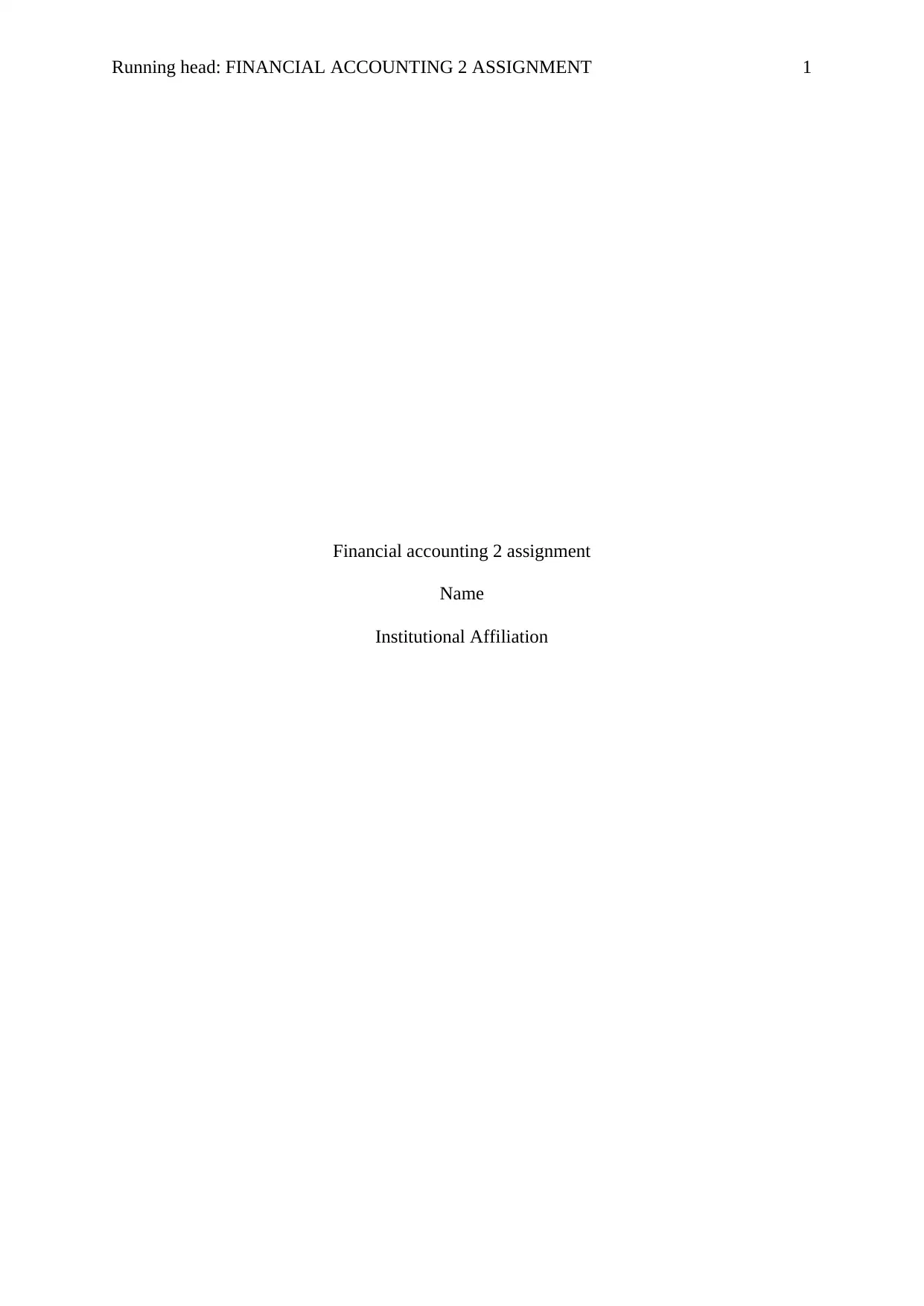
Running head: FINANCIAL ACCOUNTING 2 ASSIGNMENT 1
Financial accounting 2 assignment
Name
Institutional Affiliation
Financial accounting 2 assignment
Name
Institutional Affiliation
Paraphrase This Document
Need a fresh take? Get an instant paraphrase of this document with our AI Paraphraser
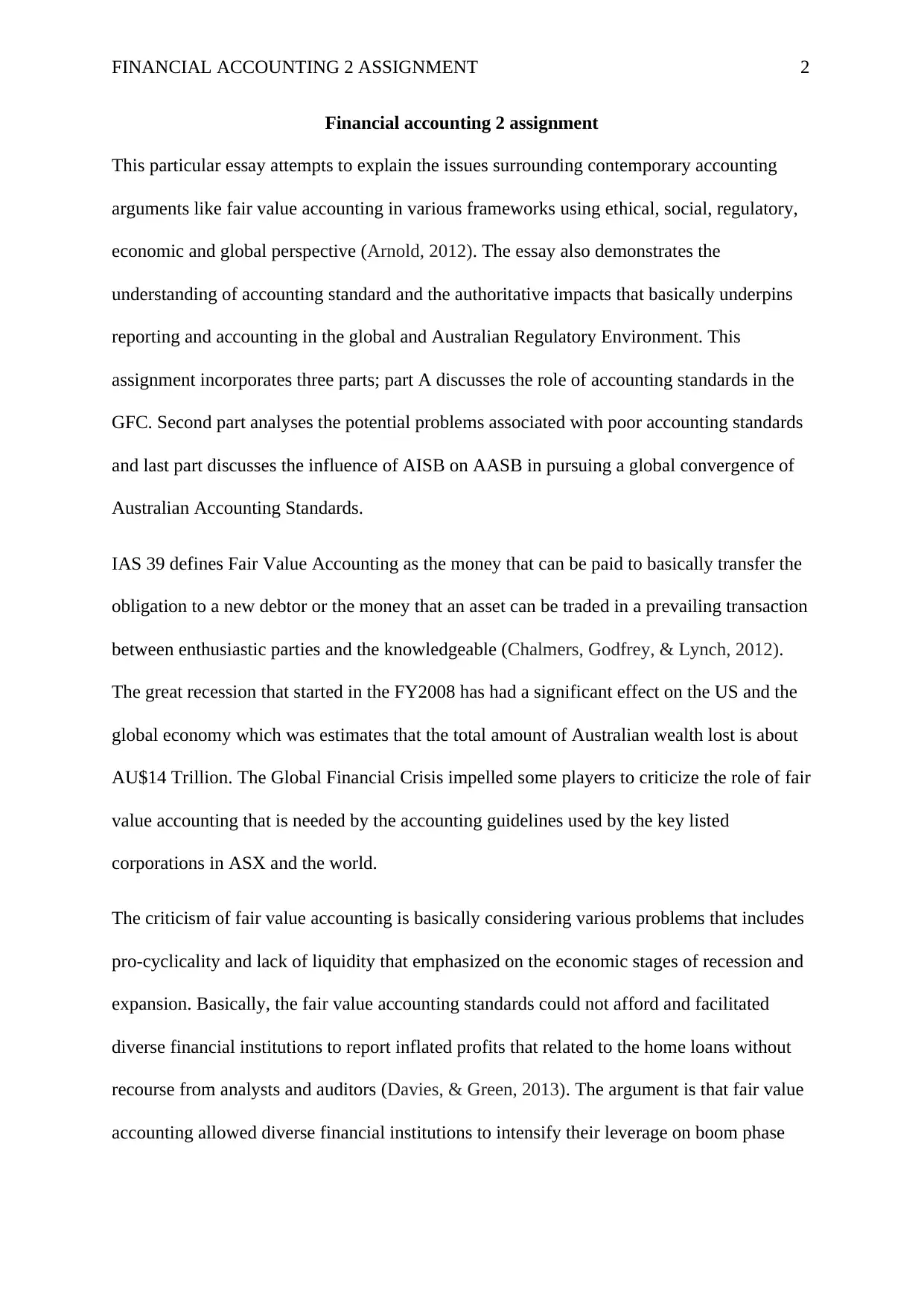
FINANCIAL ACCOUNTING 2 ASSIGNMENT 2
Financial accounting 2 assignment
This particular essay attempts to explain the issues surrounding contemporary accounting
arguments like fair value accounting in various frameworks using ethical, social, regulatory,
economic and global perspective (Arnold, 2012). The essay also demonstrates the
understanding of accounting standard and the authoritative impacts that basically underpins
reporting and accounting in the global and Australian Regulatory Environment. This
assignment incorporates three parts; part A discusses the role of accounting standards in the
GFC. Second part analyses the potential problems associated with poor accounting standards
and last part discusses the influence of AISB on AASB in pursuing a global convergence of
Australian Accounting Standards.
IAS 39 defines Fair Value Accounting as the money that can be paid to basically transfer the
obligation to a new debtor or the money that an asset can be traded in a prevailing transaction
between enthusiastic parties and the knowledgeable (Chalmers, Godfrey, & Lynch, 2012).
The great recession that started in the FY2008 has had a significant effect on the US and the
global economy which was estimates that the total amount of Australian wealth lost is about
AU$14 Trillion. The Global Financial Crisis impelled some players to criticize the role of fair
value accounting that is needed by the accounting guidelines used by the key listed
corporations in ASX and the world.
The criticism of fair value accounting is basically considering various problems that includes
pro-cyclicality and lack of liquidity that emphasized on the economic stages of recession and
expansion. Basically, the fair value accounting standards could not afford and facilitated
diverse financial institutions to report inflated profits that related to the home loans without
recourse from analysts and auditors (Davies, & Green, 2013). The argument is that fair value
accounting allowed diverse financial institutions to intensify their leverage on boom phase
Financial accounting 2 assignment
This particular essay attempts to explain the issues surrounding contemporary accounting
arguments like fair value accounting in various frameworks using ethical, social, regulatory,
economic and global perspective (Arnold, 2012). The essay also demonstrates the
understanding of accounting standard and the authoritative impacts that basically underpins
reporting and accounting in the global and Australian Regulatory Environment. This
assignment incorporates three parts; part A discusses the role of accounting standards in the
GFC. Second part analyses the potential problems associated with poor accounting standards
and last part discusses the influence of AISB on AASB in pursuing a global convergence of
Australian Accounting Standards.
IAS 39 defines Fair Value Accounting as the money that can be paid to basically transfer the
obligation to a new debtor or the money that an asset can be traded in a prevailing transaction
between enthusiastic parties and the knowledgeable (Chalmers, Godfrey, & Lynch, 2012).
The great recession that started in the FY2008 has had a significant effect on the US and the
global economy which was estimates that the total amount of Australian wealth lost is about
AU$14 Trillion. The Global Financial Crisis impelled some players to criticize the role of fair
value accounting that is needed by the accounting guidelines used by the key listed
corporations in ASX and the world.
The criticism of fair value accounting is basically considering various problems that includes
pro-cyclicality and lack of liquidity that emphasized on the economic stages of recession and
expansion. Basically, the fair value accounting standards could not afford and facilitated
diverse financial institutions to report inflated profits that related to the home loans without
recourse from analysts and auditors (Davies, & Green, 2013). The argument is that fair value
accounting allowed diverse financial institutions to intensify their leverage on boom phase
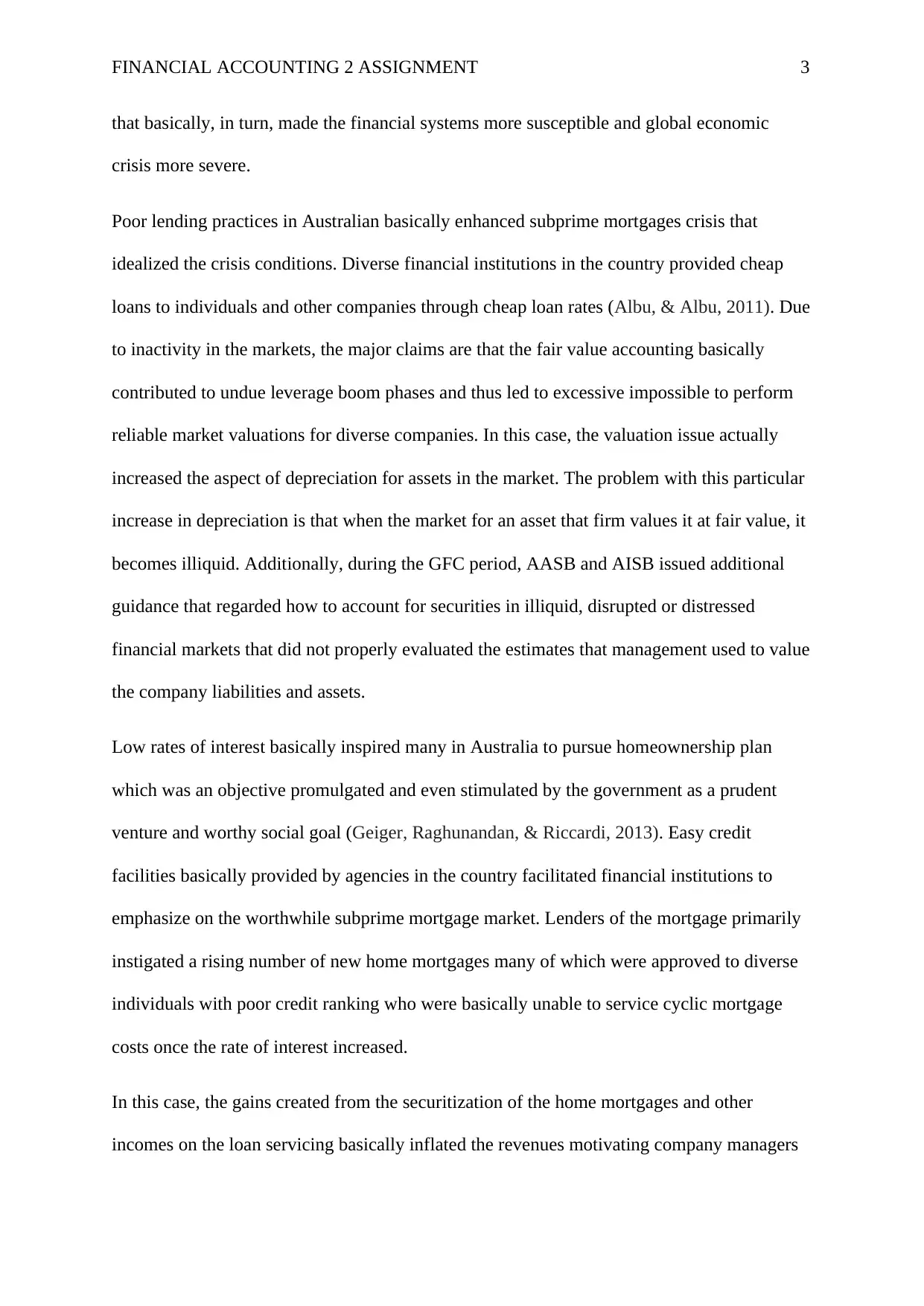
FINANCIAL ACCOUNTING 2 ASSIGNMENT 3
that basically, in turn, made the financial systems more susceptible and global economic
crisis more severe.
Poor lending practices in Australian basically enhanced subprime mortgages crisis that
idealized the crisis conditions. Diverse financial institutions in the country provided cheap
loans to individuals and other companies through cheap loan rates (Albu, & Albu, 2011). Due
to inactivity in the markets, the major claims are that the fair value accounting basically
contributed to undue leverage boom phases and thus led to excessive impossible to perform
reliable market valuations for diverse companies. In this case, the valuation issue actually
increased the aspect of depreciation for assets in the market. The problem with this particular
increase in depreciation is that when the market for an asset that firm values it at fair value, it
becomes illiquid. Additionally, during the GFC period, AASB and AISB issued additional
guidance that regarded how to account for securities in illiquid, disrupted or distressed
financial markets that did not properly evaluated the estimates that management used to value
the company liabilities and assets.
Low rates of interest basically inspired many in Australia to pursue homeownership plan
which was an objective promulgated and even stimulated by the government as a prudent
venture and worthy social goal (Geiger, Raghunandan, & Riccardi, 2013). Easy credit
facilities basically provided by agencies in the country facilitated financial institutions to
emphasize on the worthwhile subprime mortgage market. Lenders of the mortgage primarily
instigated a rising number of new home mortgages many of which were approved to diverse
individuals with poor credit ranking who were basically unable to service cyclic mortgage
costs once the rate of interest increased.
In this case, the gains created from the securitization of the home mortgages and other
incomes on the loan servicing basically inflated the revenues motivating company managers
that basically, in turn, made the financial systems more susceptible and global economic
crisis more severe.
Poor lending practices in Australian basically enhanced subprime mortgages crisis that
idealized the crisis conditions. Diverse financial institutions in the country provided cheap
loans to individuals and other companies through cheap loan rates (Albu, & Albu, 2011). Due
to inactivity in the markets, the major claims are that the fair value accounting basically
contributed to undue leverage boom phases and thus led to excessive impossible to perform
reliable market valuations for diverse companies. In this case, the valuation issue actually
increased the aspect of depreciation for assets in the market. The problem with this particular
increase in depreciation is that when the market for an asset that firm values it at fair value, it
becomes illiquid. Additionally, during the GFC period, AASB and AISB issued additional
guidance that regarded how to account for securities in illiquid, disrupted or distressed
financial markets that did not properly evaluated the estimates that management used to value
the company liabilities and assets.
Low rates of interest basically inspired many in Australia to pursue homeownership plan
which was an objective promulgated and even stimulated by the government as a prudent
venture and worthy social goal (Geiger, Raghunandan, & Riccardi, 2013). Easy credit
facilities basically provided by agencies in the country facilitated financial institutions to
emphasize on the worthwhile subprime mortgage market. Lenders of the mortgage primarily
instigated a rising number of new home mortgages many of which were approved to diverse
individuals with poor credit ranking who were basically unable to service cyclic mortgage
costs once the rate of interest increased.
In this case, the gains created from the securitization of the home mortgages and other
incomes on the loan servicing basically inflated the revenues motivating company managers
⊘ This is a preview!⊘
Do you want full access?
Subscribe today to unlock all pages.

Trusted by 1+ million students worldwide

FINANCIAL ACCOUNTING 2 ASSIGNMENT 4
to emphasize on quantity instead of the quality of debtors. In this case, fair value accounting
guidelines did not enhance high demand rate since such securities basically received high
ratings from experts who did not properly evaluate the underlying default risks (Mala, &
Chand, 2012). IASB responded by issuing IFRS 9 that provided guidelines on assets
valuations. The standard accentuates that the assets will be categorized into those that are
prized at amortized value and those values at fair value.
IASB attempted to control the fully inflated market by setting up diverse guidelines to
counter the increasing financial condition by advising diverse financial institutions to
decrease the interest rates on mortgages so as to facilitate individuals and companies to repay
back the underlying interests and loans. This aspect was done by amending and
reclassification of financial instruments (Xu, Carson, Fargher, & Jiang, 2013). The
accounting body also attempted to provide strict guidelines to financial agencies that seek to
control how mortgage could be offered to new customers. The IASBs actions are basically
likely to have an impact on global financial stability as it will assist provide guidelines that
must be followed by the financial institutions globally. The IASB action will contain greater
significance as it facilitates the stability of the global financial markets.
Prior to the FY2008 global financial crisis, diverse accounting standards were amended to
allow for reclassification of financial instruments. Some of the potential problems include,
access to capital markets could be restricted, a loss of opportunity to converge the standards
(Brown, 2011). Lack of transparency is another potential problem because the issued
financial guidelines provided prior to the GFC may not enhance consistency in the fair value
accounting. Reclassifying some of the financial statements may basically lead to
inconsistency because the information aggregation notion that basically underlie setters of the
accounting standards endorsement of fair value measurements to turn out to be theoretically
limited in its applicability and validity.
to emphasize on quantity instead of the quality of debtors. In this case, fair value accounting
guidelines did not enhance high demand rate since such securities basically received high
ratings from experts who did not properly evaluate the underlying default risks (Mala, &
Chand, 2012). IASB responded by issuing IFRS 9 that provided guidelines on assets
valuations. The standard accentuates that the assets will be categorized into those that are
prized at amortized value and those values at fair value.
IASB attempted to control the fully inflated market by setting up diverse guidelines to
counter the increasing financial condition by advising diverse financial institutions to
decrease the interest rates on mortgages so as to facilitate individuals and companies to repay
back the underlying interests and loans. This aspect was done by amending and
reclassification of financial instruments (Xu, Carson, Fargher, & Jiang, 2013). The
accounting body also attempted to provide strict guidelines to financial agencies that seek to
control how mortgage could be offered to new customers. The IASBs actions are basically
likely to have an impact on global financial stability as it will assist provide guidelines that
must be followed by the financial institutions globally. The IASB action will contain greater
significance as it facilitates the stability of the global financial markets.
Prior to the FY2008 global financial crisis, diverse accounting standards were amended to
allow for reclassification of financial instruments. Some of the potential problems include,
access to capital markets could be restricted, a loss of opportunity to converge the standards
(Brown, 2011). Lack of transparency is another potential problem because the issued
financial guidelines provided prior to the GFC may not enhance consistency in the fair value
accounting. Reclassifying some of the financial statements may basically lead to
inconsistency because the information aggregation notion that basically underlie setters of the
accounting standards endorsement of fair value measurements to turn out to be theoretically
limited in its applicability and validity.
Paraphrase This Document
Need a fresh take? Get an instant paraphrase of this document with our AI Paraphraser
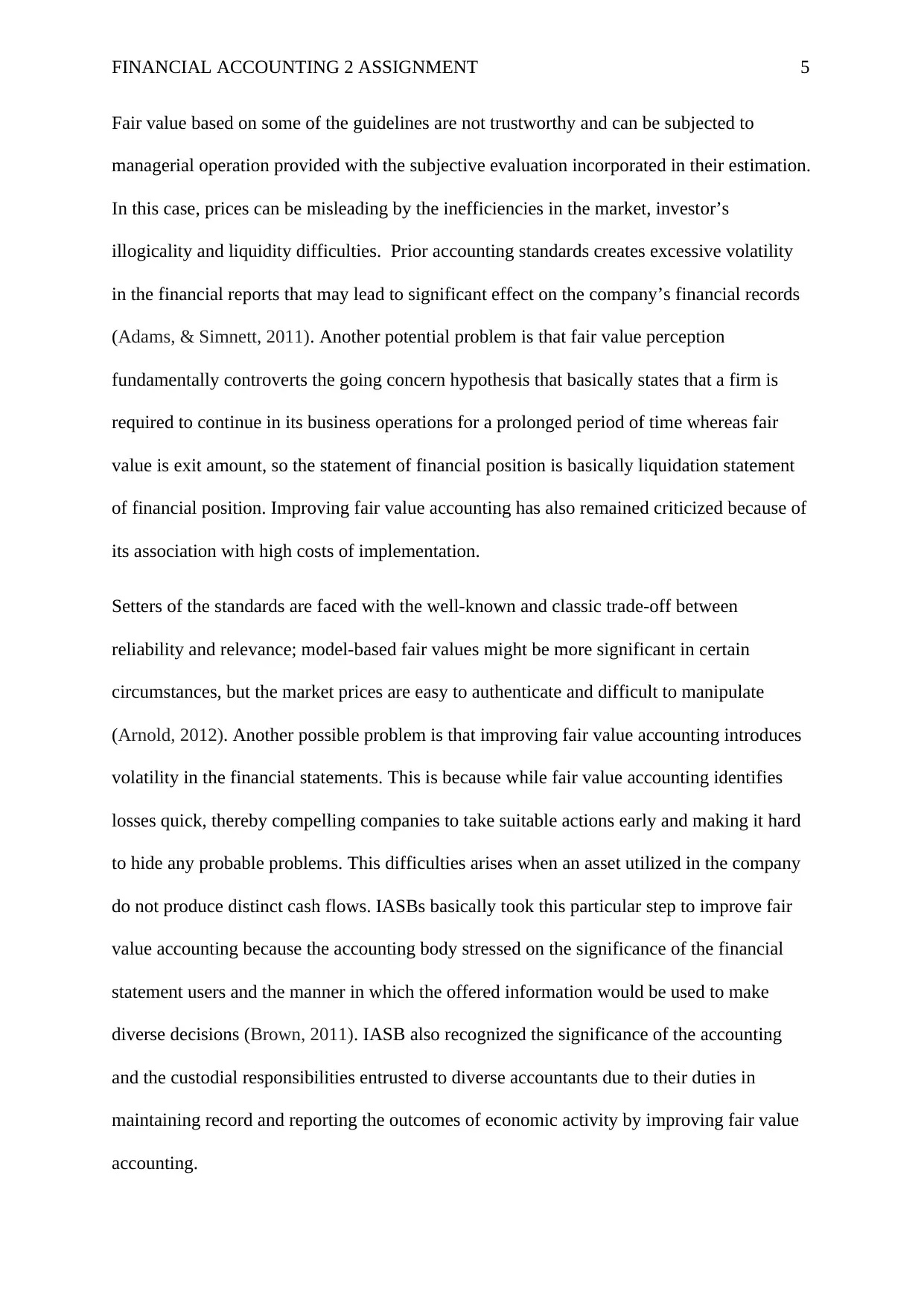
FINANCIAL ACCOUNTING 2 ASSIGNMENT 5
Fair value based on some of the guidelines are not trustworthy and can be subjected to
managerial operation provided with the subjective evaluation incorporated in their estimation.
In this case, prices can be misleading by the inefficiencies in the market, investor’s
illogicality and liquidity difficulties. Prior accounting standards creates excessive volatility
in the financial reports that may lead to significant effect on the company’s financial records
(Adams, & Simnett, 2011). Another potential problem is that fair value perception
fundamentally controverts the going concern hypothesis that basically states that a firm is
required to continue in its business operations for a prolonged period of time whereas fair
value is exit amount, so the statement of financial position is basically liquidation statement
of financial position. Improving fair value accounting has also remained criticized because of
its association with high costs of implementation.
Setters of the standards are faced with the well-known and classic trade-off between
reliability and relevance; model-based fair values might be more significant in certain
circumstances, but the market prices are easy to authenticate and difficult to manipulate
(Arnold, 2012). Another possible problem is that improving fair value accounting introduces
volatility in the financial statements. This is because while fair value accounting identifies
losses quick, thereby compelling companies to take suitable actions early and making it hard
to hide any probable problems. This difficulties arises when an asset utilized in the company
do not produce distinct cash flows. IASBs basically took this particular step to improve fair
value accounting because the accounting body stressed on the significance of the financial
statement users and the manner in which the offered information would be used to make
diverse decisions (Brown, 2011). IASB also recognized the significance of the accounting
and the custodial responsibilities entrusted to diverse accountants due to their duties in
maintaining record and reporting the outcomes of economic activity by improving fair value
accounting.
Fair value based on some of the guidelines are not trustworthy and can be subjected to
managerial operation provided with the subjective evaluation incorporated in their estimation.
In this case, prices can be misleading by the inefficiencies in the market, investor’s
illogicality and liquidity difficulties. Prior accounting standards creates excessive volatility
in the financial reports that may lead to significant effect on the company’s financial records
(Adams, & Simnett, 2011). Another potential problem is that fair value perception
fundamentally controverts the going concern hypothesis that basically states that a firm is
required to continue in its business operations for a prolonged period of time whereas fair
value is exit amount, so the statement of financial position is basically liquidation statement
of financial position. Improving fair value accounting has also remained criticized because of
its association with high costs of implementation.
Setters of the standards are faced with the well-known and classic trade-off between
reliability and relevance; model-based fair values might be more significant in certain
circumstances, but the market prices are easy to authenticate and difficult to manipulate
(Arnold, 2012). Another possible problem is that improving fair value accounting introduces
volatility in the financial statements. This is because while fair value accounting identifies
losses quick, thereby compelling companies to take suitable actions early and making it hard
to hide any probable problems. This difficulties arises when an asset utilized in the company
do not produce distinct cash flows. IASBs basically took this particular step to improve fair
value accounting because the accounting body stressed on the significance of the financial
statement users and the manner in which the offered information would be used to make
diverse decisions (Brown, 2011). IASB also recognized the significance of the accounting
and the custodial responsibilities entrusted to diverse accountants due to their duties in
maintaining record and reporting the outcomes of economic activity by improving fair value
accounting.

FINANCIAL ACCOUNTING 2 ASSIGNMENT 6
The Australian Accounting Standards Board reacted to the global financial crisis by
implementing numerous stricter accounting principles including the IFRS and GAAP
accounting systems. This action was basically done so as to prevent such financial crisis and
its ill impacts in the future (Tarca, 2012). AASB basically responded to the GFC by
introducing the following measurements based on the US GAAP:
Present value measurement
Historical cost
Acquisition cost for non-financial or intangible assets
Depreciation
Fair value measurement
Basically, implementing the International Financial Reporting Standards (IFRS) is considered
to be a significant idea since it would be compatible with all accounting guidelines and
acceptable to stakeholders, merchants and also companies. But this practices has been
designed from the English perceptions and is not related to the US GAAP Australian or the
GAAP. Its implementation would basically face a lot of resistance (Adams, & Simnett,
2011). There may be a lot of initial resistance and hiccups. Furthermore changing from one
model to another brings in a lot of problems in the preliminary stages, as there will be
uncertainty about how to carry over the preceding financial year balances. This aspect will
interrupt the global trading accounting and practices of multi-national firms because
basically, its implementation is a challenging activity, but it is beneficial in the long run.
The Australian Accounting Standards Board reacted to the global financial crisis by
implementing numerous stricter accounting principles including the IFRS and GAAP
accounting systems. This action was basically done so as to prevent such financial crisis and
its ill impacts in the future (Tarca, 2012). AASB basically responded to the GFC by
introducing the following measurements based on the US GAAP:
Present value measurement
Historical cost
Acquisition cost for non-financial or intangible assets
Depreciation
Fair value measurement
Basically, implementing the International Financial Reporting Standards (IFRS) is considered
to be a significant idea since it would be compatible with all accounting guidelines and
acceptable to stakeholders, merchants and also companies. But this practices has been
designed from the English perceptions and is not related to the US GAAP Australian or the
GAAP. Its implementation would basically face a lot of resistance (Adams, & Simnett,
2011). There may be a lot of initial resistance and hiccups. Furthermore changing from one
model to another brings in a lot of problems in the preliminary stages, as there will be
uncertainty about how to carry over the preceding financial year balances. This aspect will
interrupt the global trading accounting and practices of multi-national firms because
basically, its implementation is a challenging activity, but it is beneficial in the long run.
⊘ This is a preview!⊘
Do you want full access?
Subscribe today to unlock all pages.

Trusted by 1+ million students worldwide
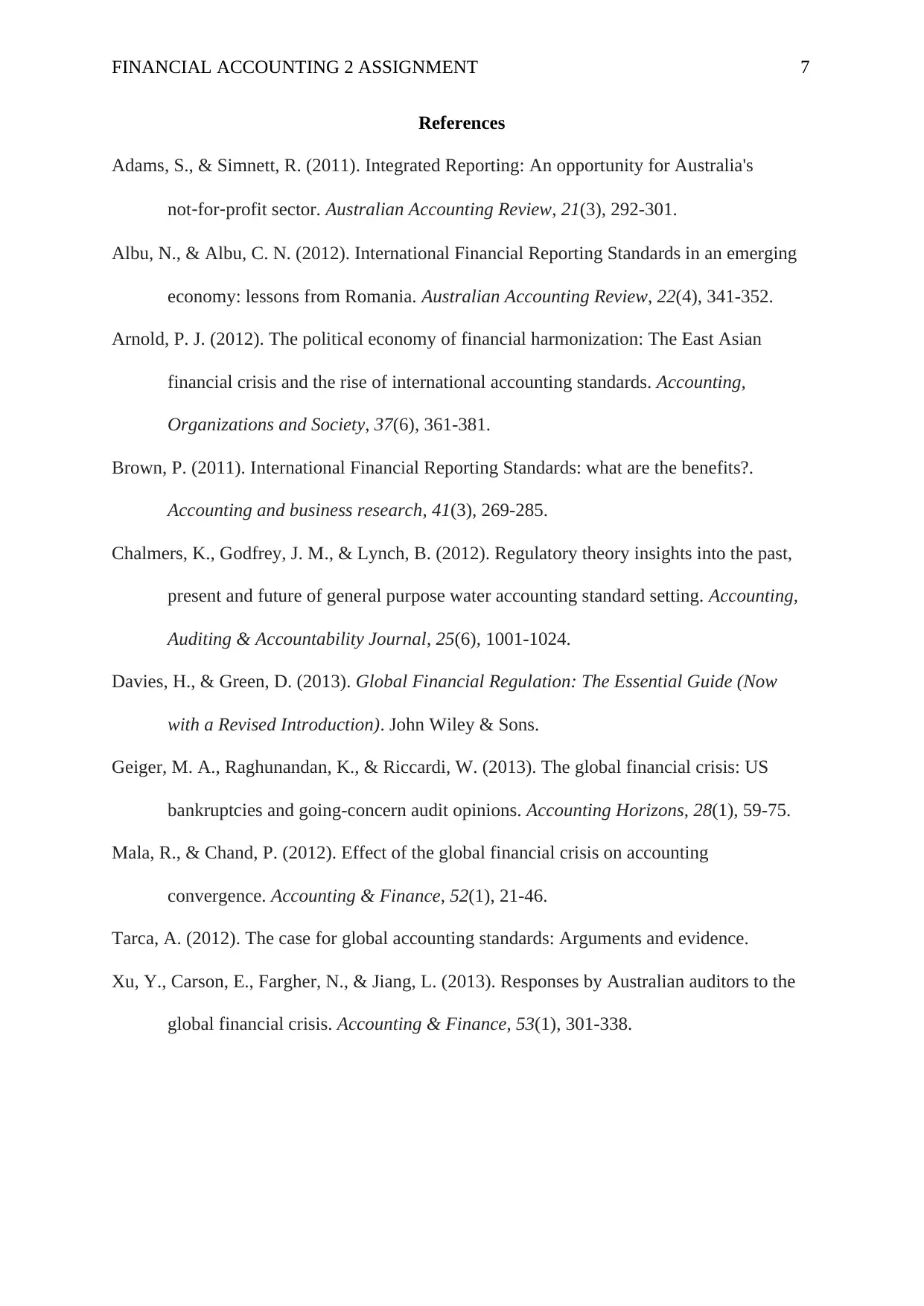
FINANCIAL ACCOUNTING 2 ASSIGNMENT 7
References
Adams, S., & Simnett, R. (2011). Integrated Reporting: An opportunity for Australia's
not‐for‐profit sector. Australian Accounting Review, 21(3), 292-301.
Albu, N., & Albu, C. N. (2012). International Financial Reporting Standards in an emerging
economy: lessons from Romania. Australian Accounting Review, 22(4), 341-352.
Arnold, P. J. (2012). The political economy of financial harmonization: The East Asian
financial crisis and the rise of international accounting standards. Accounting,
Organizations and Society, 37(6), 361-381.
Brown, P. (2011). International Financial Reporting Standards: what are the benefits?.
Accounting and business research, 41(3), 269-285.
Chalmers, K., Godfrey, J. M., & Lynch, B. (2012). Regulatory theory insights into the past,
present and future of general purpose water accounting standard setting. Accounting,
Auditing & Accountability Journal, 25(6), 1001-1024.
Davies, H., & Green, D. (2013). Global Financial Regulation: The Essential Guide (Now
with a Revised Introduction). John Wiley & Sons.
Geiger, M. A., Raghunandan, K., & Riccardi, W. (2013). The global financial crisis: US
bankruptcies and going-concern audit opinions. Accounting Horizons, 28(1), 59-75.
Mala, R., & Chand, P. (2012). Effect of the global financial crisis on accounting
convergence. Accounting & Finance, 52(1), 21-46.
Tarca, A. (2012). The case for global accounting standards: Arguments and evidence.
Xu, Y., Carson, E., Fargher, N., & Jiang, L. (2013). Responses by Australian auditors to the
global financial crisis. Accounting & Finance, 53(1), 301-338.
References
Adams, S., & Simnett, R. (2011). Integrated Reporting: An opportunity for Australia's
not‐for‐profit sector. Australian Accounting Review, 21(3), 292-301.
Albu, N., & Albu, C. N. (2012). International Financial Reporting Standards in an emerging
economy: lessons from Romania. Australian Accounting Review, 22(4), 341-352.
Arnold, P. J. (2012). The political economy of financial harmonization: The East Asian
financial crisis and the rise of international accounting standards. Accounting,
Organizations and Society, 37(6), 361-381.
Brown, P. (2011). International Financial Reporting Standards: what are the benefits?.
Accounting and business research, 41(3), 269-285.
Chalmers, K., Godfrey, J. M., & Lynch, B. (2012). Regulatory theory insights into the past,
present and future of general purpose water accounting standard setting. Accounting,
Auditing & Accountability Journal, 25(6), 1001-1024.
Davies, H., & Green, D. (2013). Global Financial Regulation: The Essential Guide (Now
with a Revised Introduction). John Wiley & Sons.
Geiger, M. A., Raghunandan, K., & Riccardi, W. (2013). The global financial crisis: US
bankruptcies and going-concern audit opinions. Accounting Horizons, 28(1), 59-75.
Mala, R., & Chand, P. (2012). Effect of the global financial crisis on accounting
convergence. Accounting & Finance, 52(1), 21-46.
Tarca, A. (2012). The case for global accounting standards: Arguments and evidence.
Xu, Y., Carson, E., Fargher, N., & Jiang, L. (2013). Responses by Australian auditors to the
global financial crisis. Accounting & Finance, 53(1), 301-338.
1 out of 7
Related Documents
Your All-in-One AI-Powered Toolkit for Academic Success.
+13062052269
info@desklib.com
Available 24*7 on WhatsApp / Email
![[object Object]](/_next/static/media/star-bottom.7253800d.svg)
Unlock your academic potential
Copyright © 2020–2025 A2Z Services. All Rights Reserved. Developed and managed by ZUCOL.





